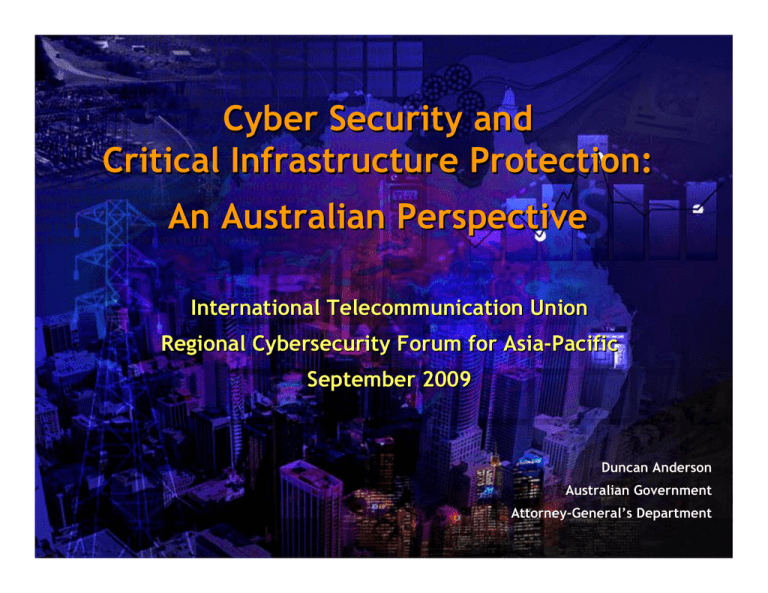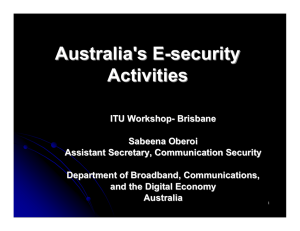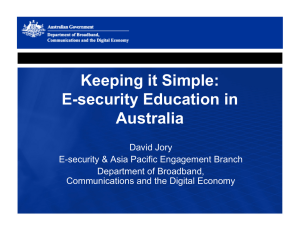Cyber Security and Critical Infrastructure Protection: An Australian Perspective International Telecommunication Union
advertisement

Cyber Security and Critical Infrastructure Protection: An Australian Perspective International Telecommunication Union Regional Cybersecurity Forum for Asia-Pacific September 2009 Duncan Anderson Australian Government Attorney-General’s Department Australia’s Digital Landscape: Snapshot • • Australia’s digital economy – 21.5 million population – 8.4 million active Internet subscribers – 7.3 million (87%) with ‘broadband’ National Broadband Network – • • 100 mbps to 90% population Increasing scale and sophistication of threats – 17.7 million malware infections in 2008 – 3,060 compromised computers per day – Annual cost of computer security incidents $595-$649 million Top national security priority Australia’s Cyber Security Policy • E-Security National Agenda – • • Secure and trusted operating environment for public and private sectors Priorities – Government systems – Critical infrastructure – Home users and small to medium enterprises Integrated with critical infrastructure protection strategy – Electronic, physical, personnel and procedural security Trusted Information Sharing Network for Critical Infrastructure Protection (TISN) Critical Infrastructure Advisory Council(CIAC) (CIAC) Critical Infrastructure Advisory Council Infrastructure Assurance Advisory Groups Based) Infrastructure Assurance Advisory Groups(Sector (IAAGs) Banking & Finance (AGD) Emergency Services (EMA) Communications Communications (DBCDE) December 2007 Mass Gatherings (AGD) Food Chain Food Chain (DAFF) Energy (DRET) Health (DHA) Expert Advisory Groups Expert Advisory Groups (EAGs) Water Services (AGD) Transport (DITRDaLG) CIP Futures (AGD) Security ITITSecurity (DBCDE) SCADA Community of Interest (DBCDE) Critical Infrastructure Protection Modelling and Analysis (CIPMA) SYSTEM SYSTEM MODELLING MODELLING DECISION DECISION SUPPORT SUPPORT ECONOMIC SOCIAL INFORMATION INFORMATION & & DATA DATA INVESTMENT BUSINESS CONTINUITY ELECTRICITY SECURITY GAS RESILIENCE LIQUID FUELS COMMUNICATIONS BROADCASTING BANKING & FINANCE WATER E-Security Review: Key Outcomes • • Cyber Security Operations Centre – Consolidated situational awareness – Coordinated operational response – Located within Defence Signals Directorate, with multi-agency expertise – Operational mid 2009 New National CERT – Primary interface with private sector (systems of national interest) – Trusted information exchanges (communications, banking, SCADA) – Primary Australian contact in global CERT community – Amalgamating GovCERT.au and (selected) AusCERT functions – Operational early 2010 E-Security Review: Other Outcomes • • Internet Gateway Consolidation – Enhance security while maintaining redundancy – Broader work on security of government systems Internet Service Provider Code of Practice – • Educate and protect users International Engagement Strategy – Incident response, legal frameworks and law enforcement cooperation, critical infrastructure protection, capacity building – Bilateral, regional, multilateral institutions Future Directions • New Policy Framework – • Research and Development – • Released later in 2009 National Security Science and Innovation Strategy Crisis Management Plan – Cyber security incidents of national significance – Exercise Cyber Storm III Conclusions • Government leadership role, in partnership with business and the community (domestically and internationally) • Integrated approach against ‘all hazards’ and interdependenices • Security is an enabler to providing trusted and resilient systems Questions? Thank You Duncan Anderson Australian Government Attorney-General’s Department duncan.anderson@ag.gov.au


